

WHERE CAN I GET A CUSTOM MOLD MADE?
►NOTE: We DO NOT manufacture molds.
►Any local CNC machine shop in your area should be able to produce a custom mold to your specifications.
Here is some useful information about mold design:
Basic Mold Design Tips
or we recommend any of the partners below - that can make affordable custom aluminum molds:
►Contact www.benchtopmold.com - Chantilly, VA - (703) 879-8750
or
►Contact Derrick Feigel - Markle, IN - (260) 414-1703
or
►Contact Southern Indiana Tool & Fabrication, Inc. - Jeff Pankake - (812) 430-2966
or
►Contact Fred Mehary - Stonegate Creations Studio - Corpus Christi, TX
CAN THE MOLD BE FILLED BY MULTIPLE PULLS OF THE HANDLE?
►NO, that is not possible with ANY machine. Every plastic injection machine has a maximum amount of plastic (called shot size) that it can inject into a mold with a single pull.
►If the volume of the mold is larger than the machine's shot size, you need to purchase a larger machine.
►Once you determine the volume of plastic needed to fill your mold, you then can select a machine that is able to inject (at least) that same volume of plastic.
►Your mold maker or CNC software can tell you the volume of plastic (shot size) needed to fill your mold.
WHAT ARE THE CAPACITIES OF THE DIFFERENT MACHINES?
►The Model 20A has been DISCONTINUED.
►The Model 150A can reach 500 deg.F and can inject up to 1.0 cubic inches of plastic or 16 grams (shot size).
►The Model 150A shipping weight is 60 lbs and ships UPS Ground. The shipping dimensions are 24 inches x 18 inches x 14 inches tall.
►The Model 150A operates on 120VAC, 50/60Hz @ 4 Amps.
►The Model 300A can reach 500 deg.F and can inject up to 2.0 cubic inches of plastic or 32 grams (shot size).
►The Model 300A shipping weight is 62 lbs and ships UPS Ground. The shipping dimensions are 30 inches x 15 inches x 15 inches tall.
►The Model 300A operates on 120VAC, 50/60Hz @ 5 Amps.
WHAT ARE THE MAXIMIUM OUTSIDE DIMENSIONS OF A MOLD FOR THE MODEL 150A?
►NOTE: We DO NOT manufacture molds. See above for partners that can make custom molds for our machine.
►The heights of the Model 150A and the Model 300A machines are adjustable, so they can accept molds up to 8 inches wide x 5 inches tall x 5 inches deep.
►The sprue hole in the top of the mold should be 1/4 inch diameter to mate with the nozzle.
[Note: adding a chamfer to the sprue hole will help guide the nozzle into the hole.]
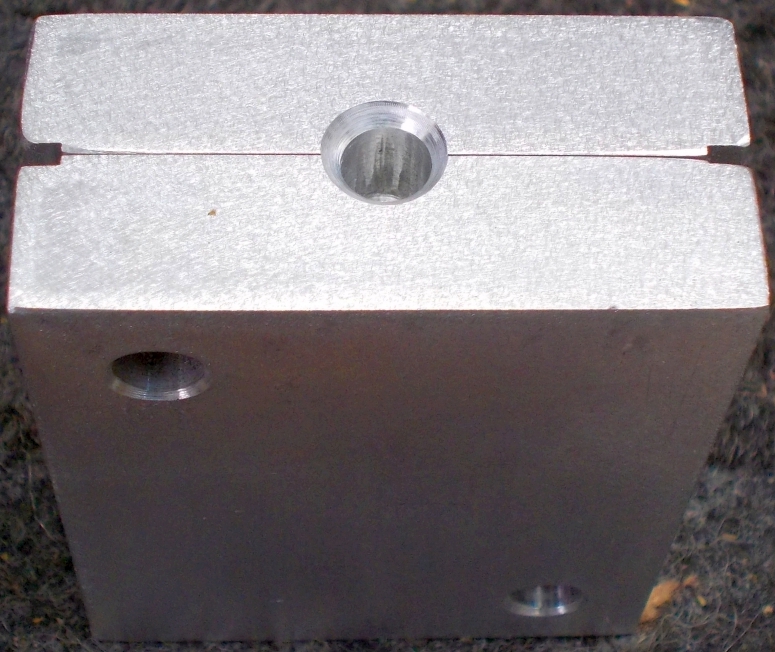
CAN RECYCLED PLASTIC BE USED IN THESE MACHINES?
♻ Rejected molded parts or scrap can be cut into small pieces and placed back into the barrel.
♻ Also, clean recycled PS, ABS, PLA, PETG, LDPE, HDPE or PP plastics (but not PET or PETE) can be cut into small pieces and used in this machine.





WHY ARE NYLON, POLYCARBONATE, PET AND PVC MATERIALS UNSUITABLE FOR THESE MACHINES?
►Polycarbonate and PET plastics typically require high melting temperatures above 500 deg F. for injection.
►Due to the unique properties of Nylon, we have been UNABLE to get it to work properly in our machines.
IMPORTANT NOTE: Using Nylon in this machine will VOID the return policy!
► ⚠WARNING⚠ PVC plastic can emit ☠ TOXIC ☠ vapors when heated and PVC can corrode the steel parts of the machine.
IMPORTANT NOTE: Using PVC in this machine will VOID both the warranty and the return policy!
WHERE CAN LARGER QUANTITIES OF PELLETS BE PURCHASED?
►Premier Plastic Resins can supply many types of thermoplastic pellets in 55 lb boxes.
Click on the LOGO below to view their website.

►Also this Ebay seller is offering several colors of Polypropylene (PP) pellets.
Click BELOW to view their Ebay store.
BOYPLASTIC
I SET THE RECOMMENDED TEMPERATURE, BUT THE MATERIAL IS DIFFICULT TO INJECT.
►Each batch of thermoplastic polymer has a Melt Flow Index (MFI) or Melt Flow Rate (MFR) value.
The MFI or MFR is a measure of how easily the material will flow when melted.
Plastic pellets with a high MFI value will be much easier to inject than the same type of pellets with a low MFI value.
Note: All the pellets sold on our webpage have a high MFI value and have been tested to work in our machines.
If you purchase pellets from another source, be sure they have a high (greater than 12) MFI value.
►Click HERE for an in-depth guide about why Melt Flow Index (MFI) is an important consideration when choosing plastic resins for injection molding
►Also, the recommended temperatures for a polymer should be used only as a starting point.
If the material does not flow, then gradually increase the temperature setting in 5 to 10 degree increments until you get satisfactory results.
Note: the temperature is TOO HIGH if the material from the nozzle is discolored, emits fumes or contains gas bubbles.
DO I HAVE TO PURGE THE PLASTIC FROM THE MACHINE BEFORE TURNING IT OFF?
►Purging is NOT required - The machine can be turned off with plastic material still in the barrel.
The plastic material in the barrel will re-melt when the machine is turned back on.
►Purging is only necessary when changing colors or types of materials.
►Do NOT attempt to clean plastic from the barrel by disassembling it!
Simply use the new material to push out the previous material.
Note: The nozzles are NOT designed to be removed from the barrel!
CAN I CREATE A NEW COLOR BY ADDING 2 DIFFERENT COLOR PELLETS INTO THE MACHINE?
►Large industrial injection machines have a rotating screw that can mix colors evenly before the injection.
However, the Model 150A machine has a fixed ram instead of a rotating screw,
so the colors will NOT mix uniformly to create a new color (see photo below).
Instead, they create beautiful randomly swirled patterns!
The swirled colors will also happen during the switch-over (or purging) to a new material.
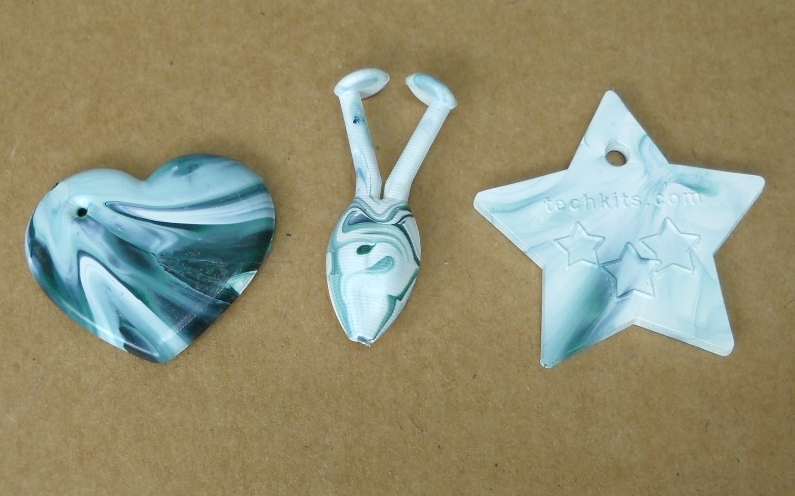
CAN I USE 3D PRINTED MOLDS FOR PLASTIC INJECTION?
►YES! - 3D printed molds can be used (see photo below).
However due to the high pressures and temperatures during the injection cycle, 3D printed molds need to be held inside a metal frame.
We sell 2 sizes of aluminum frames for making epoxy molds. You can purchase frames here:
Aluminum Frames for Epoxy Molds
Use the highest temperature resin or filament to print the 3D mold because it will be exposed to hot plastic during injection.
You also need to cool the 3D printed mold after each injection to avoid heat build-up.
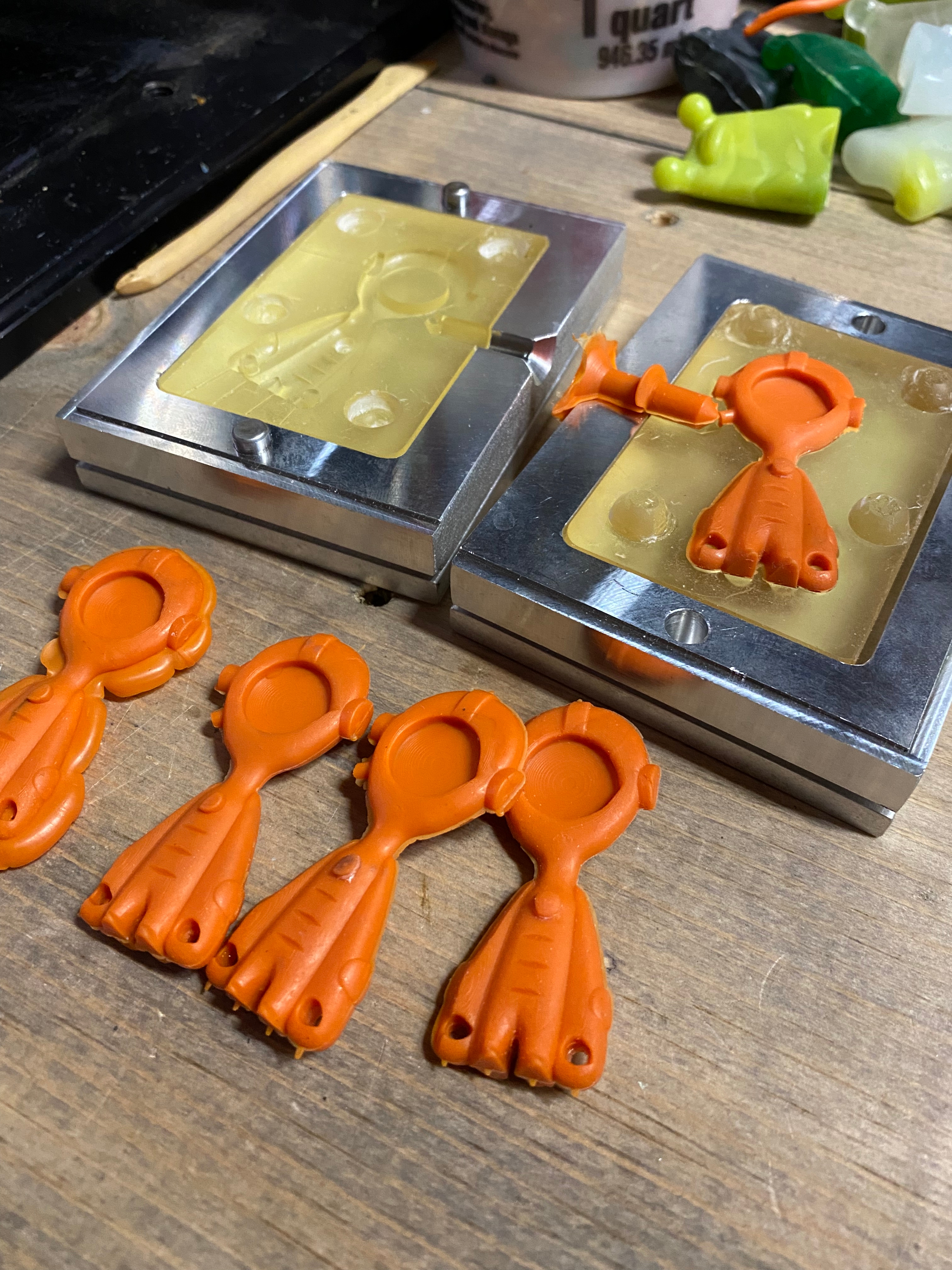
CAN I USE SILICONE OR RUBBER MOLDS FOR PLASTIC INJECTION?
►YES! - Rubber or silicone molds can be used (see photo below).
However since the injection machine can exert over a thousand pounds of pressure during injection, you must take special precautions.
Placing the rubber or silicone mold into a metal frame is recommended.
This will prevent the machine's nozzle from deforming the mold. It also keeps the mold from expanding when the plastic enters under high pressure.
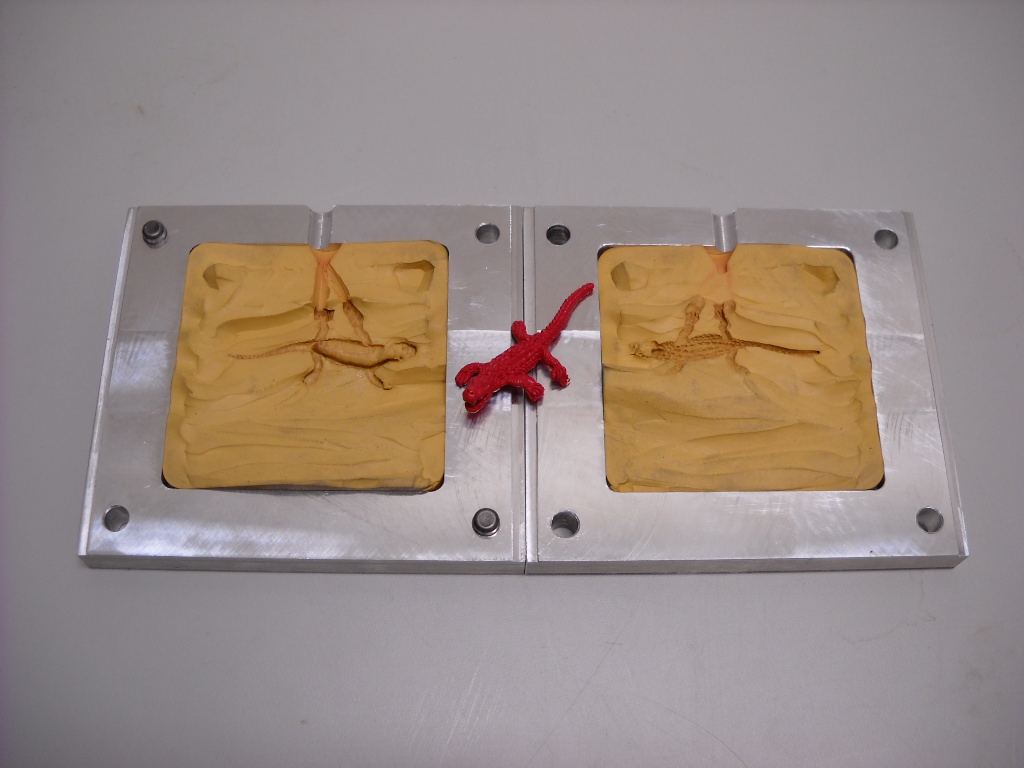
CAN I USE EPOXY MOLDS FOR PLASTIC INJECTION?
►YES! - Epoxy molds can be used to reproduce Figurines or Action Figures, etc. (see photos below).
We sell 2 sizes of aluminum frames for making epoxy molds. You can purchase frames here:
Aluminum Frames for Epoxy Molds
We recommend using Devcon 10710 for making epoxy molds. (see photo below).
Here are basic instructions for making epoxy molds:
Instructions for Epoxy Molds
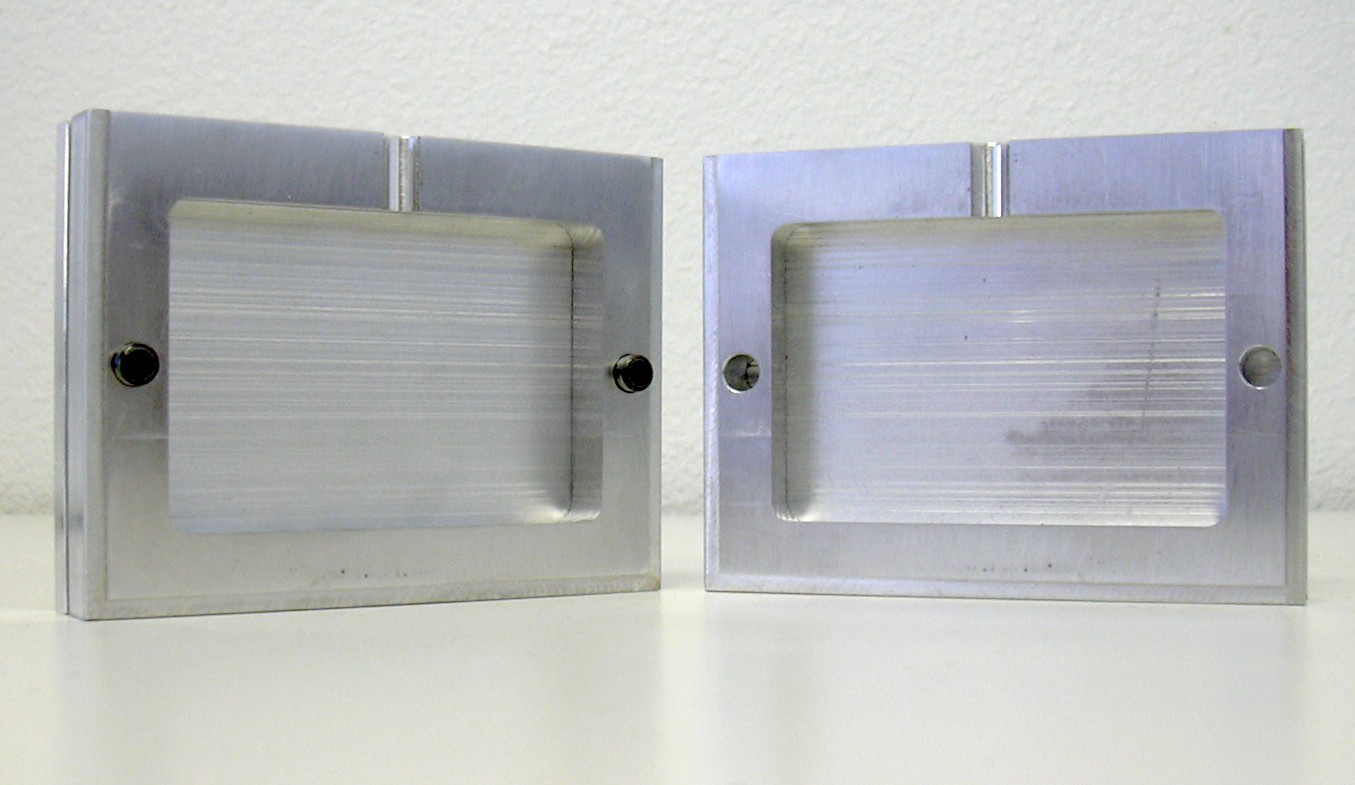
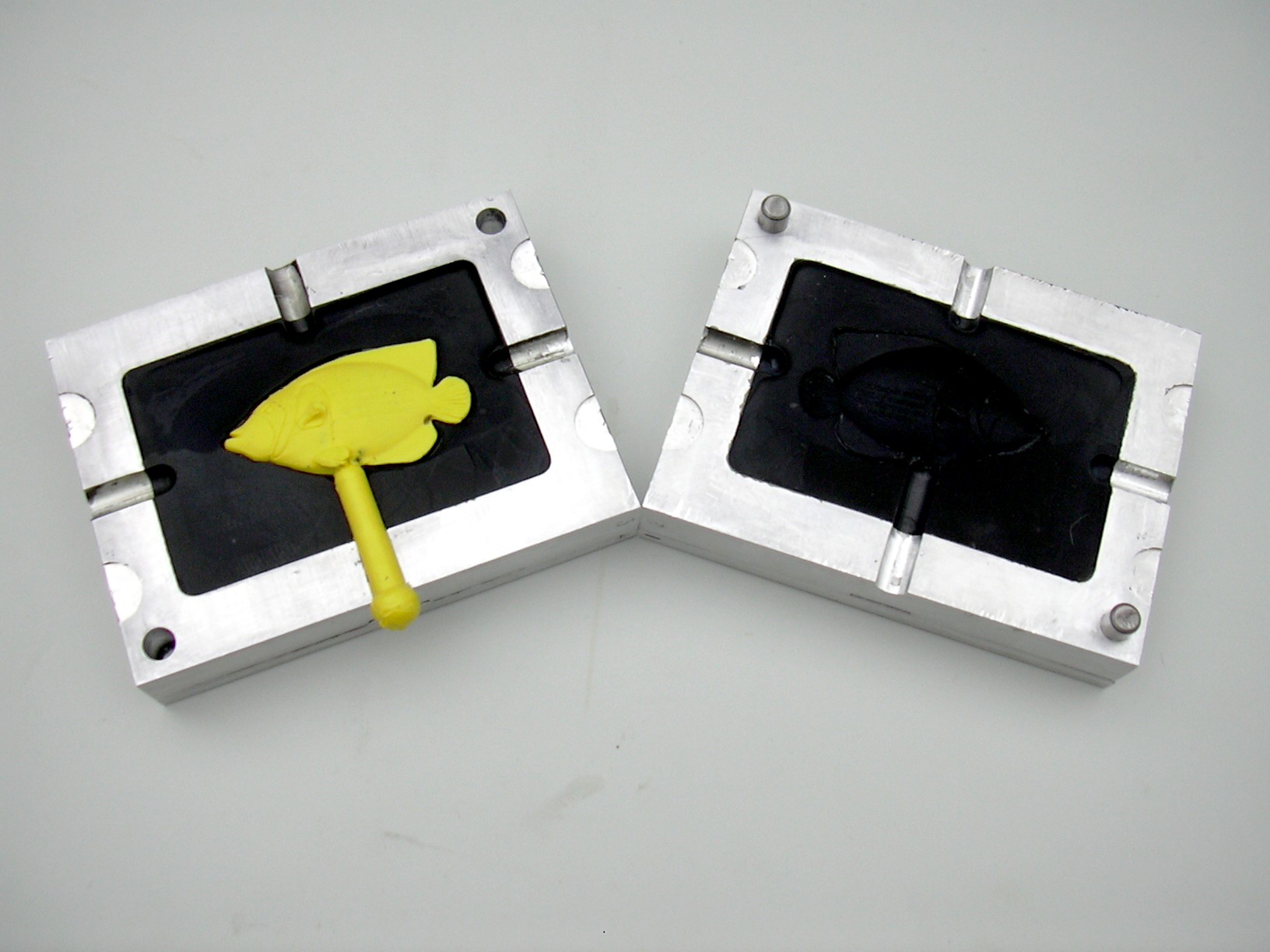
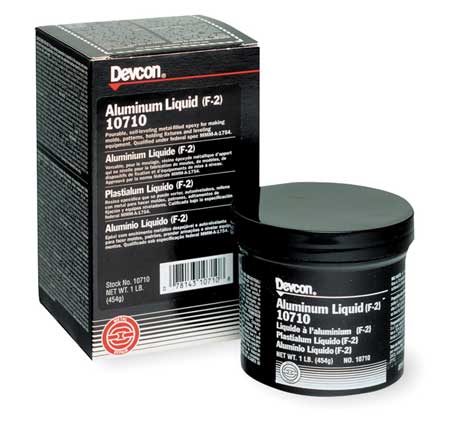
CAN THE MODEL 150A PRODUCE OPTICALLY CLEAR PARTS?
►YES! - Injection grade plastics (M30 Acrylics, Eastman Tenite, etc) will work in the Model 150A. (see photo below)
NOTE: Acrylic pellets need to be pre-dried before injection to produce defect free parts.
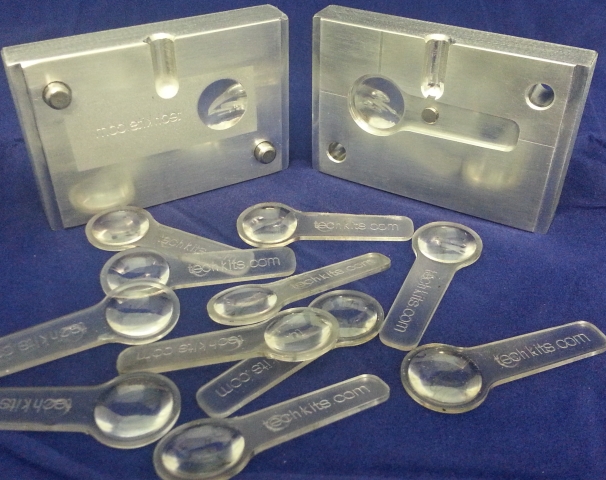
WHAT IS THE BEST WAY TO PRE-HEAT THE MOLDS (IF NEEDED)?
►A simple, economical & repeatable way to pre-heat the mold is to use a hot plate with adjustable temperature settings (see photo below).
Using protective gloves, place the mold flat on the hot plate for a fixed time or use a thermometer to determine a more precise pre-heat temperature.
►Alternatively, a hair dryer or hot air gun can be used to pre-heat the mold by blowing hot air onto it.
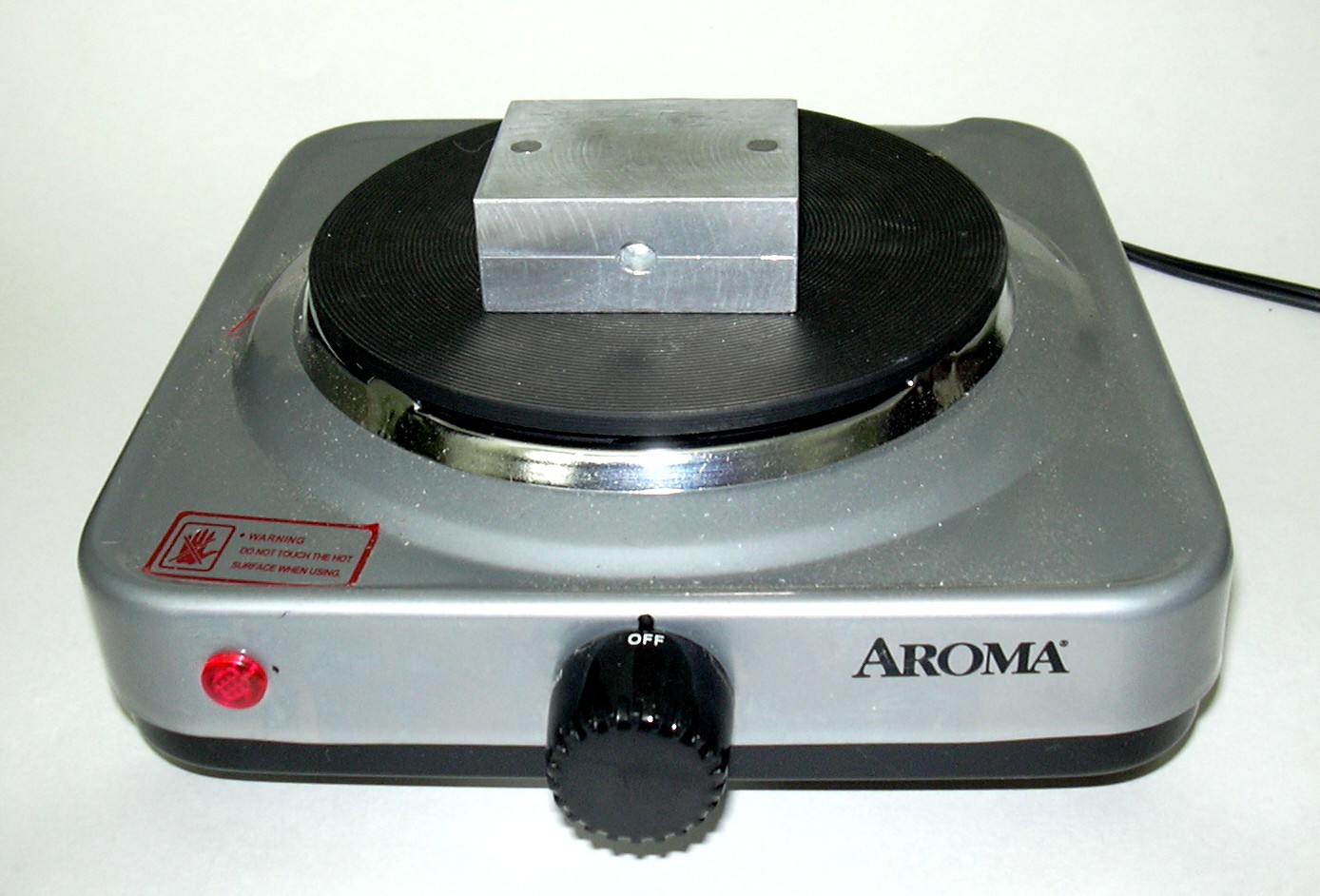
INTERNATIONAL SHIPPING?

